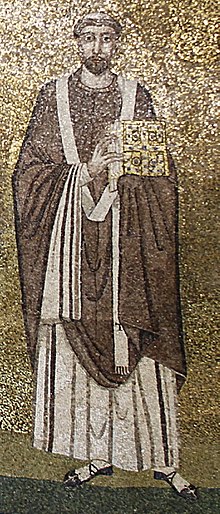Pope Symmachus
|
Pope Saint Symmachus |
|
|---|---|
 |
|
| Papacy began | 22 November 498 |
| Papacy ended | 19 July 514 |
| Predecessor | Anastasius II |
| Successor | Hormisdas |
| Personal details | |
| Birth name | Symmachus |
| Born | Unknown date Sardinia, Vandal Kingdom |
| Died | 19 July 514 Rome, Ostrogothic Kingdom |
| Sainthood | |
| Feast day | 19 July |
| Venerated in | Roman Catholic Church |
|
Papal styles of Pope Symmachus |
|
|---|---|
 |
|
| Reference style | His Holiness |
| Spoken style | Your Holiness |
| Religious style | Holy Father |
| Posthumous style | Saint |
Pope Symmachus (died 19 July 514) was Pope from 22 November 498 to his death in 514. His tenure was marked by a serious schism over who was legitimately elected pope by the citizens of Rome.
He was born on the Mediterranean island of Sardinia (then under Vandal rule), the son of Fortunatus; Jeffrey Richards notes that he was born a pagan, and "perhaps the rankest outsider" of all the Ostrogothic Popes, most of whom were members of aristocratic families. Symmachus was baptized in Rome, where he became Archdeacon of the Roman Church under Pope Anastasius II (496-498).
Symmachus was elected pope on 22 November 498 in the Constantinian basilica (S. Giovanni Laterano). The archpriest of Santa Prassede, Laurentius, was elected pope that same day at the Basilica S. Mariae (presumably S. Maria Maggiore) by a dissenting faction with Byzantine sympathies, who were supported by Eastern Roman Emperor Anastasius. Both factions agreed to allow the Gothic King Theodoric the Great to arbitrate. He ruled that the one who was elected first and whose supporters were the most numerous should be recognized as pope. This was a purely political decision. An investigation favored Symmachus and his election was recognized as proper. However, an early document known as the "Laurentian Fragment" claims that Symmachus obtained the decision by paying bribes, while deacon Magnus Felix Ennodius of Milan later wrote that 400 solidi were distributed amongst influential personages, whom it would be indiscreet to name.
Symmachus proceeded to call a synod, to be held at Rome on 1 March 499, which was attended by 72 bishops and all of the Roman clergy. Laurentius attended this synod. Afterwards he was assigned the diocesis of Nuceria in Campania. According to the account in the Liber Pontificalis, Symmachus bestowed the See on Laurentius "guided by sympathy", but the "Laurentian Fragment" states that Laurentius "was severely threatened and cajoled, and forcibly despatched" to Nuceria (Nocera Umbra, east of Assisi). The synod also ordained that any cleric who sought to gain votes for a successor to the papacy during the lifetime of the pope, or who called conferences and held consultations for that purpose, should be deposed and excommunicated.
...
Wikipedia
